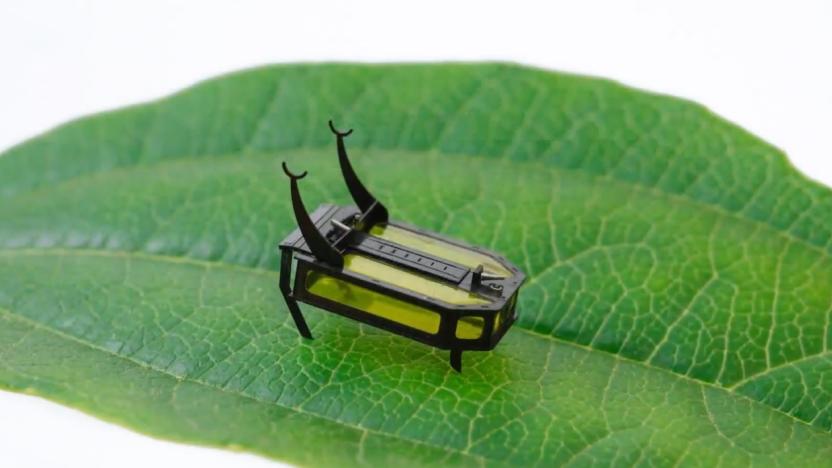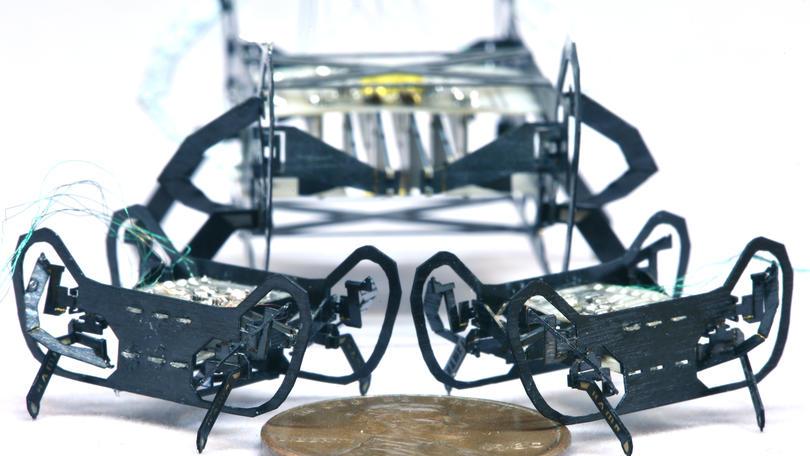microrobot
Latest

This tiny robotic beetle travels for two hours without a battery
This tiny, autonomous robotic beetle runs on liquid methanol.

Harvard shrank its insect-inspired microrobot to the size of a penny
Harvard researchers have made the tiny Harvard Ambulatory Microrobot (HAMR) even tinier. The next-gen HAMR-JR is one of the smallest and fastest microrobots to date.

Tiny robotic scallops can swim through blood and eyeball fluid to fix you up
For years now, scientists have been trying to develop microscopic robots that can swim through bodily fluids and repair damaged cells or deliver medicine. Now, scientists from the Max Planck Institute for Intelligent Systems in Germany believe they've got the perfect design -- in the form of scallops so small, they can barely be seen by the naked eye. These micro-robo-scallops move back and forth to swim through blood, eyeball fluids and other liquids inside our body. The scientists believe mimicking the way a true scallop swims is ideal, due to a number of reasons.

Researchers power microbots made of bubbles with lasers
They may not be "robots" as most have come to expect, but these so-called microrobots developed by a team of researchers from the University of Hawaii at Manoa do have at least one thing in common with many of their mechanical counterparts: lasers. As IEEE Spectrum reports, the bots themselves are actually nothing more than bubbles of air in a saline solution, but they become "microrobots" when the laser is added to the equation, which serves as an engine of sorts and allows the researchers to control both the speed and direction of the bubbles. That, they say, could allow the bots to be used for a variety of tasks, including assembling microstructures and then disappearing without a trace when the bubble is popped. Head on past the break for a video of what they're already capable of.

Researchers use graphene to draw energy from flowing water, self-powered micro-robots to follow?
What can't graphene do? The wonder material's been at the heart of a stunning number of technological breakthroughs of late, and now it's adding oil exploration to its long list of achievements. A team of researchers at Rensselaer Polytechnic Institute have discovered that the flow of good old H2O over a sheet of graphene can generate enough electricity to power "tiny sensors" used in tracking down oil deposits. The gang, led by professor Nikhil Koratkar, was able to suck 85 nanowatts of power out of a slab of graphene measuring .03 by .015 millimeters. The little sensors the researchers speak of are pumped into potential oil wells via a stream of water, and are then put to work sniffing out hydrocarbons indicative of hidden pockets of oil and natural gas. Of course, that doesn't have a whole lot of practical application for your average gadget consumer, but Koraktar sees a future filled with tiny water-powered robots and micro-submarines -- we can dig it.

Micro machines experience thrill of victory, agony of defeat at Mobile Microrobotics Challenge
It's time to take a glimpse into the future -- the future of what will someday be swimming in your bloodstream. Video highlights from the 2010 NIST Mobile Microrobotics Challenge have started trickling out, and we're mighty impressed. Through various events, like the 2mm dash, universities and institutions competed to determine whose tiny contraptions would reign supreme. Various competitors won various prizes, with the French CNRS team spanning that 2mm distance in an amazing 32ms, while Swiss team ETH Zurich showed its prowess at slotting 100µm pins (human hair sized) into impossibly small holes. That's a picture of one of the competition arenas above, and we think you'll want to see the video of ETH's tiny bulldozer doing its thing after the break. In a few years we figure these little suckers will be doing something like this in your body, but instead of assembling puzzles they'll be overcoming natural defenses and removing your will to live.

Micromuscle makes microrobots that can live inside you
While artificial muscles stand poised to bring a new world of tactility to touchable devices, there's still hope they might fulfill some bigger, loftier goals -- like helping to save lives. That's a large part of where the research at Micromuscle is focused, creating a series of electroactive polymers that do impressive things when placed under small voltages, changing shape and even volume as demonstrated in the Engineering TV clip embedded below. In it you can see a few examples of these things folding into complex, golden structures on their own accord, but the main application seems to be things like catheters that can steer themselves through the bloodstream, drug delivery mechanisms that can deploy multiple substances on command, and even microscopic robots that can pick up tiny things and move them tiny distances. You know what this means: robot armageddon might actually start from the inside.[Via Engineering TV]

Microrobot's UBOT cleaning robot
Korean manufacturer Microrobot's UBOT cleaning robot seems to have its sights set clearly on the ever-growing Roomba army (and from the looks of it, may have already eaten one). Unlike the Roomba, however, the UBOT is only intended for use on hard floors, with a 60W vacuum to suck up the dirt, although it lacks the Scooba's squeegee-action, instead using an advanced cloth-dispensing system to pick up what the vacuum misses (kinda like a RoboSwiffer). Still, it should be able to find its way around your place on its own and avoid any obstacles, even if it might not fit under much of your furniture. A higher-end model is also available that features what Microrobot calls a "2D barcode navigation system," which promises to clean rooms more efficiently -- how, exactly, we're not sure. The UBOT does look to have the Roomba beat in one important area though, featuring a voice guide to inform you of its conditions in a "soft and calm tone." Sound familiar?[Via AVING.net]




